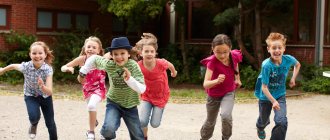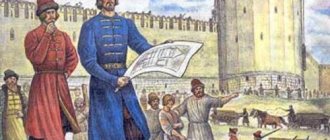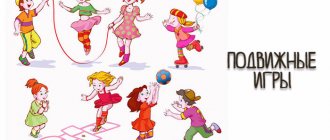How are outdoor outdoor games beneficial for children?
Outdoor games have a positive effect on a child’s physical activity and development. Children learn orientation in space, their coordination of movements improves. In addition, energetic games give the child a lot of positive emotions, which have a beneficial effect on his mood and health.
Children who often love outdoor games eat with great appetite, fall asleep easily and sleep soundly, and are less susceptible to whims and sudden mood swings. If a baby leads an inactive lifestyle in early childhood, then at an older age he will quickly get tired.
High physical activity is an excellent prevention of health problems such as muscle weakness and obesity. Most children's outdoor games involve active interaction with other children and adults. Therefore, the child socializes well, learns to quickly react to different situations in life and communicate with peers.
What exactly do street outdoor games develop?
During the game, certain skills are mastered and improved, the work of internal organs of all systems is activated, and brain function improves. Physical, psychological and social qualities develop.
The main physical qualities that enhance outdoor play are:
- Force;
- Agility;
- Flexibility;
- Rapidity;
- Endurance.
Outdoor games, especially competitions, are good for developing analytical thinking in a child. In addition, the following intellectual qualities improve:
- Logics;
- Deduction;
- Critical thinking;
- Abstract thinking;
- Ability to forecast;
- Creative thinking;
- Long-term concentration on solving a specific problem.
By interacting with peers in play, the child learns communication skills, to be tolerant of mistakes, to work in a team, and to solve common problems. Children learn to distribute responsibilities among themselves and share responsibility together. They learn to give in to each other, compromise and listen to the opinions of other children. The main social qualities that joint outdoor games develop in children are:
- Independence;
- Hard work;
- Kindness;
- Courage;
- Honesty;
- Respect;
- Responsibility;
- Self-confidence.
Age characteristics of children 4-6 years old
To choose interesting and useful outdoor games, you need to take into account the age characteristics of children. For example, at 3-4 years old children do not yet have full control of their body and get tired quickly. And for children 4-6 years old the following features are characteristic:
- They maintain their balance well and can step over small obstacles.
- Improves coordination and dexterity.
- Children can perform quite complex exercises and concentrate on one game for a long time.
Take into account the characteristics of children's development when selecting exercises.
Types of outdoor games
Outdoor games with a ball
Games using a ball help children develop coordination, attention and involvement in a common team activity. And of course, such games always give a lot of fun and joy.
"Crocodile" . Two teams of 5–6 people stand in a row one behind the other. Each pair holds a ball between them; hands cannot be used. The goal is to reach the finish line faster. The team that reaches the end without dropping the ball wins.
"Potato" . Players stand in a circle and pass the ball to each other, bouncing it away from themselves. The child who does not hit the ball stands in the center, and the rest continue the game. Any participant can knock out the person sitting, after which he returns to the game. The “punished” player must also try to catch the flying ball. If he succeeds, he starts playing again, and the child who threw the ball takes his place.
"Ball over the head" . Two teams line up in rows with the backs of their heads facing each other. The first players take the balls. At a signal from an adult, they pass them over the heads of the players behind them, they pass the ball to the next ones, and so on until the end. The last players must run around their teams, stand at the beginning of the formation and start the game again, passing the balls between the legs of the participants. The third players in a row, after receiving the ball, run forward and again pass the balls over their heads. The winner is the team that quickly replaces all players and does not get confused in the correct sequence.
"Catch - don't sleep!" . The children stand in a circle with their backs to him. The adult leader, standing in the center of the circle, holds the ball in his hands and counts from one to five. Having finished the countdown, he calls one of the players by name and throws the ball up. The player whose name the host called must quickly turn around and catch the ball. This must be done when the ball is in flight or has hit the ground once. A player who fails the task three times leaves the game.
"We're looking for the ball!" . Children stand in a circle as close to each other as possible, while holding their hands behind their backs. The game begins with children passing a small ball to each other behind their backs. The adult driver, standing inside the circle, needs to guess which of the children now has the ball. Addressing different players in turn, he says: “Show your hands!” The participant must extend both arms forward. If he has the ball, he becomes the driver.
"We're hunting geese . Two teams participate: geese and hunters. The hunters stand behind a large circle, the geese remain inside it. After the signal, the hunters try to hook the geese with the ball, which in turn must dodge it. The greasy goose is eliminated from the game. When all the geese are salted, team members change places. You can set a certain time for the game, then the team that knocks out the most geese is declared the winner.
"Bouncer" . Two participants stand on opposite edges of the established area. Everyone else stands in a row in the middle of it, facing the “bouncer.” He throws the ball, trying to touch it to any of the players on the field. If this happens, then the player loses and goes off the court. Now the second bouncer throws the ball. It is important that the ball is light.
Street games for girls
"Rubber band" . There are various variations of games using a regular elastic band, which is tied into a ring.
"Secret" . One of the girls digs a small hole in the sand, hides a small object there and buries it again with sand. The point of the game is that you need to hide your secret more securely and find where the other team’s secret item is hidden.
"Daughters and Mothers" . There are no specific rules or instructions here. Girls bring their “children” to the street - dolls, bottles, clothes, toys. They feed, rock, and change dolls. Or the girls themselves become mothers and daughters by agreement.
Games for boys
"War" . A traditional boys' game in which boys imitate soldiers and fight.
"Cossacks-robbers" . The team of robbers guesses the password and runs away. At the same time, participants mark their path with arrows on walls, trees and asphalt. After some time, a team of Cossacks begins to chase the robbers. The found participant is brought to headquarters and they try to find out the password. The goal of the game is to find all the robbers and discover the secret word. More detailed rules can be found here.
Outdoor games by age
Games for the little ones
Outdoor games for young children under two years of age should be simple and understandable. Children at this age already have the skills of normal walking, jumping, running on two and one leg, they can go down and up, throw and step over. Learning the rules of the game should be discreet and natural, without any elements of coercion.
"Bees" . An adult transforms into a bee. He imitates her buzzing and flying, flapping his wings (arms) freely and easily. The bees must collect nectar from the flowers and return to the hive with it. Flowers can be painted on the asphalt or real. The hive can also be drawn in the form of a circle or laid out on the ground with a jump rope or string.
"Crawling snake" . You need to secure a jump rope or rope above the grass so that children can crawl under it. The rope falls lower and lower until the participant begins to lift it in order to crawl freely.
"Turtle Race" . Here you also need to crawl through the grass, only without a rope. The one who crawls slowest to the finish line wins.
"Obstacle course" . You can use logs, branches, sticks, and buckets as obstacles. It is necessary to secure each participant during difficult and dangerous moments in order to avoid injuries.
“Fly, airplanes!” . First you need to make as many paper airplanes as possible. And then arrange a competition in which the child whose airplane flies the farthest wins.
"Sunny Bunny" . The game must be played in sunny weather. You will need a small mirror for this. Catch sunbeams and ask your child to chase them.
"Small birds" . Invite the kids to imagine that they are restless and jumping birds. You need to jump and wave your arms at the same time. You can jump in place on two legs, or back and forth. If this is difficult for a child, then help him by holding his hand or under his armpits.
"Jumping over puddles" . A very simple game for which you just need to put on rubber boots for your child and find more puddles.
Street games for preschoolers 2-4 years old
At the age of two to four years, preschoolers become more active and resilient. They are becoming more and more interested in team games with other children. Kids strive to show off their achievements and skills to other people.
"Teddy Bear" . Using a counting rhyme, a “bear” is chosen. On one edge of the site there will be a bear’s den, on the other – a children’s house. In the center of the site is a forest edge. Children leave the house and go to the edge of the forest to pick berries. The bear suddenly runs out and tries to catch someone. The caught player becomes a "bear".
"Biking with obstacles" . If your child is already good at riding a tricycle, you can make it more difficult for them. Create an obstacle course for him using toys, wooden sticks and plastic bottles. Draw arrows next to them with chalk. The child must practice driving around obstacles and not hitting them. After the child has successfully completed the task, you can give him a small prize.
"Classics" . Since children do not yet know how to jump on one leg, they are allowed to jump on two.
Outdoor games for children 5-7 years old
“Bring the bag . The child walks between sticks placed 40 centimeters apart. At the same time, he has a bag of dry sand on his head. The child’s task is to reach the end without dropping the bag on the ground. It is important not to stuff the bag too tightly, as this will make it difficult to hold. Instead of a bag, you can use books, baskets and other items.
"Game with a hoop" . The child should roll the hoop in front of him, while trying not to drop it on the ground. The task is to roll the hoop to the finish line.
"Collecting tapes" . A rope with colored ribbons thrown on it is stretched between the trees. The ends of the ribbons should be slightly higher than the children's raised hands. They stand under the rope and jump, removing as much tape as possible.
"Catch" . Two children take turns throwing a ball to each other. The third participant, standing between them, tries to catch him. If he succeeds, then he takes the place of the child throwing the ball.
"Corners" . Children stand in pre-drawn corners. One player who does not have a corner stands in the middle of the court and asks one of those standing to give him his corner. He refuses. Then the player approaches the other with the same request, and at this time the participants change places, and he tries to take the place of one of them.
Summer Games
In the summer, babies, preschoolers and elementary school students want to spend a lot of time outdoors and play with friends. Therefore, it is important to use this period as beneficially as possible for the development and health of the child.
"Bouncing Bunny" . Children line up along a line and jump on two legs in three jumps. The one who jumps the farthest in these three times is the winner.
"Who is more resilient" . Participants raise their knees bent. At the same time, keep your hands on your belt and close your eyes. The winner will be the one who stays in this position longer than the rest.
Winter Games
The fabulous winter time gives free rein to children's imagination and street creativity. The adult’s task is to help the little fidgets a little. When there is a lot of snow outside, you definitely need to go for a walk with the whole family.
"Let's go sledding . The simplest, most fun and exciting activity. The only caveat is that very young children must ride with adults.
"Snow Angel" . The child needs to plop down in the snow with his back and start waving his legs and arms around, as if imitating the flight of an angel. Then the adult helps the child stand up carefully so that he can evaluate the resulting figure.
. " This is one of the most common winter activities in which there are no restrictions on creativity. Together with your child, you can make both a simple snowman and a fancy animal. A snowman turned upside down or figures sculpted sitting on benches look funny.
The most fun and unusual outdoor games
"Twister (like a quest)" . You need to draw circles on the asphalt with colored chalk. The size of the field and the diameter of the circles depends on how old the children are. They can also be painted on the lawn using water-based paints, which will wash off at the first rainy weather.
"Tarpaulin knocked out" . To organize the game you will need colored tape and a piece of tarpaulin. You need to cut several holes of different sizes and shapes in it. Their edges need to be covered with colored tape. Each hole is assigned a point value. The winner of the game is the participant who collects the maximum number of them in a certain number of throws.
"Hunting for treasures" . First of all, you need to make a list of treasures that the guys will have to collect. For example, leaves, flowers, cones, twigs, stones and so on. The generated lists must be pasted on the bags that are given to the players. The winner will be the participant who collects all the treasures faster than the rest.
"Bottle Bowling" . To play you need ten plastic bottles, a small ball and paint. Painted and dried bottles need to be filled with water and the original skittles are ready.
"Throw accurately . Here you need the help of a dad or another adult man. You will need to attach two or three buckets of different capacities with screws to a long board, which you then need to lean against the wall. For each ball hit in the bucket, the player receives points. In this case, the smaller the bucket, the more points are awarded.
"Throwing balloons" . To play you will need noodles. Children must use them to throw as many balloons into the basket as possible. A very simple game, but quite fun.
"Noughts and Crosses" . The principle of the game is the same as in the paper version. But on the street there is a larger selection of equipment and improvised items. For example, you can use large stones or wooden blocks.
"Tug of war " The popular game will become much more interesting if players stand not on the ground, but on stumps or overturned boxes. In this version, children will need to show both strength and dexterity.
"Treasures from Ice" . Children will especially enjoy this game during hot weather. Freeze water with various small items and toys in a container. Then give it to the children along with the hammer. And in the next hour they will definitely have something to do. More water play ideas.
" Darts with inflatable balls" . You need to first inflate the balloons and attach them to the board with tape. Lots of noise and fun guaranteed.
"Land Games" . The rules here are the same as in regular board games. One difference: instead of figures there will be children themselves. The cube can be made from an ordinary cardboard box. With chalk you need to draw the trajectory of the path that needs to be overcome and place all the marks - steps back and forward, return to the start.
“Throw accurately – 2.” The game is more difficult than the first version. Instead of buckets, a stepladder is used. All steps are assigned points, which participants must score as many as possible.
A selection of exercises for children 4-6 years old
We recommend using a selection of these outdoor games during walks with the average group.
Hippo
Goal: development of dexterity and attention.
The game begins with the children, together with the teacher, reading a rhyme and using it to choose a “hippopotamus” who will drive:
Our cheerful hippopotamus walks backwards. The one he touches
Run away quickly.
Children stand in a circle and begin to dance in a circle. “Behemoth” moves 4-8 meters away from them, turns its back to the round dance and begins to back away. When the “hippopotamus” touches the back of any child, it turns around. Children count to three. On the count of THREE, the “hippopotamus” and the child he touched scatter in different directions. Whoever ran around the round dance first and stood in an empty place won, and whoever didn’t make it in time becomes a “hippopotamus”.
Bouncing toys
Goal: development of dexterity, attention, coordination of movements and the ability to catch objects.
What you will need for the game: a net or a piece of fabric, several soft toys.
Four children hold a net filled with soft toys. The rest of the children stand opposite. Holding the net, the children begin to swing it, while simultaneously saying:
Jumping, jumping, we'll rock the toys. Now let’s throw it up (with these words, those who hold the net throw the toys up). Whoever catches it will be successful! (the rest of the kids catch the thrown toys).
Then the children change places: those who held the net begin to catch the toys, and vice versa.
Urban jungle
Goal: development of dexterity, attention and coordination of movements.
What you will need for the game: buckets, balls, cars, cubes and any other toys.
Toys are placed on the playground in a random order, but so that you can run between them. Then the teacher commands “Start”, turns on cheerful music and the children begin to run around the playground. Their task is to move so as not to collide with their peers and not knock over the toys that are placed on the playground. The one who knocks down an object or collides with a friend is eliminated from the game. The exercise continues until there is no player left who will be the winner.
Grab it while you can!
Goal: development of dexterity, attention and coordination of movements.
What you will need for the game: various large objects, for example, toys.
The teacher places objects around the playground. Their number should be 1 less than the number of players. The teacher turns on cheerful music and commands “Start”. With this command, children grab one object at a time. The one who gets nothing is eliminated from the game. The next round begins. Usually the exercise is carried out until there is only one winner left.
Centipede
Goal: development of dexterity, attention, coordination of movement, ability to perceive tasks by ear.
The exercise begins with an introductory conversation. The teacher asks the kids if they know who a centipede is. If not, then he tells them about it.
Children line up in a column one after another and place their hands on the waist of the person in front. The teacher becomes the head of the centipede. He begins to say what actions the centipede should perform. The children's task is to understand by ear what needs to be done and perform this action.
For example:
— The centipede is small, so you need to squat down. — Show how the centipede walks, stretches, washes itself, eats, dances. — The centipede’s tail catches up with its head.
Plasticine figures
Goal: development of attention, listening skills, imagination and dexterity.
The teacher chooses one leader, and invites the rest to join in a round dance. The leader stands with his back to the round dance, which begins to move and say:
Plasticine, plasticine, There are many of us, and you are alone. We count: one, two, three. What did they blind? Speak!
As soon as the quatrain ends, the children throw up their hands, quickly come up with a figure and freeze in it. The presenter turns to the children and tries to guess what each pose means. The child whose figure he guessed on the first try becomes the new leader.
Legs are not friends
Goal: development of dexterity, coordination of movements and the ability to listen to tasks.
The teacher draws a large circle with chalk or a stick and divides it into 8 sectors. Each sector gets its own number. Children line up in front of the circle. The teacher names two numbers - from 0 to 8. The player must jump into the circle so that his feet are in those sectors whose numbers the driver named. For example, he named 1 and 7, which means the player’s feet should be in sector 1 and sector 7. If the child does not succeed, he is eliminated from the game. The turn moves to the next child. The game lasts until one of the smartest players remains.
When planning activities, alternate active and calm games so that children can relax and catch their breath. Make sure that the kids find it interesting and fun to do the exercises.
Precautionary measures
An adult who organizes outdoor games for children must clearly know the rules and essence, certain movements, in order to be able to easily explain them to children. Before the start of the game, it is necessary to inspect the site, check special devices, equipment, benches, stands for damage and breakage. Children's shoes and clothing should be appropriate for their age and season, not restrict movement or loosen.
During the game, the adult must organize the children so that they do not injure themselves and each other. You need to instruct your child that when jumping and dismounting, you need to land lightly on your toes, crouching slightly. This will compensate for the body's load on the legs.
It is important to alternate active, energetic games with calm and intellectual games. In the summer, it is better to play in a place on the site where there is shade and coolness. In winter, you need to jump and run more to keep warm.
After the games are over, you need to check how the children are feeling and collect sports equipment and toys. Even though children are warmed up, they should not be given cold water to drink or allowed to walk around undressed in cool weather.
Tips for parents
Children playing together with their parents benefits both. Children experience joy and bright emotions, and adults can get to know their child better and become closer to him. This is important in order to make childhood unforgettable and interesting for the child. Therefore, do not be lazy to play with him, do not be afraid to seem frivolous and funny, be a friend to him.
The games discussed in the article can be played both in the yard of the house and in a preschool or summer camp.
If you liked the article, please share a link to it








